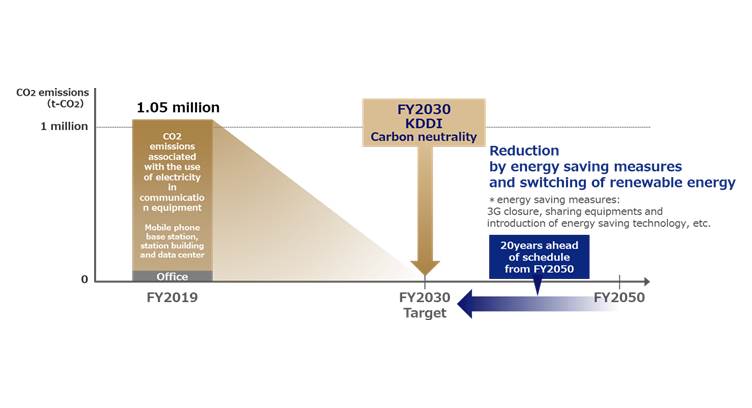KDDI plans to accelerate its carbon neutrality timetable and intends to achieve zero CO2 emissions in its business activities by FY2030.
In addition, the KDDI Group aims to achieve zero CO2 emissions at its worldwide data centers under the Telehouse brand by FY2026. The KDDI Group as a whole aims to achieve zero CO2 emissions by FY2050.
In May 2020, KDDI declared its goal of achieving zero CO2 emissions by FY2050 in the KDDI Sustainable Action, KDDI's SDGs for the year 2030. Subsequently, in response to the Japanese government's April 2021 target to reduce greenhouse gas emissions by 46% by 2030 (compared to FY2013), KDDI has been studying ways to achieve carbon neutrality faster and aims to reach its goal 20 years faster than previously stated.
KDDI emits approximately 1 million tons of CO2 annually through energy consumption, such as electricity, which is equivalent to about 500,000 average households. Of this amount, 98% is attributable to electricity used at base stations, communication stations, and data centers; and is expected to increase further with the spread of 5G and the increase in telecommunications volumes. Therefore, in order to achieve carbon neutrality much earlier than previously planned, KDDI will reduce power consumption at base stations and telecommunication facilities; and use renewable energy.
Regarding power saving, KDDI expects reductions due to the 3G shutdown caused by the termination of au's "CDMA 1X WIN" service for 3G cell phones at the end of March 2022.In addition, KDDI will work to reduce CO2 emissions through partnerships and the introduction of new technologies in the areas of power conservation and renewable energy.In FY2024, we aim to reduce CO2 emissions from communication stations and data center by introducing energy-efficient solutions with Intel's latest generation Xeon Scalable processors. The processors include built-in comprehensive power management and artificial intelligence capabilities that enables us to consistently predict communication volumes and optimize telecommunication equipment, enabling us to achieve up to 20% reduction in power consumption. We are also able to utilize advanced liquid immersion systems as an innovative means to cool IT equipment.
The Operator is also considering the future introduction of "perovskite solar cells," which are expected to become the next-generation solar cells, into KDDI's base stations.





















